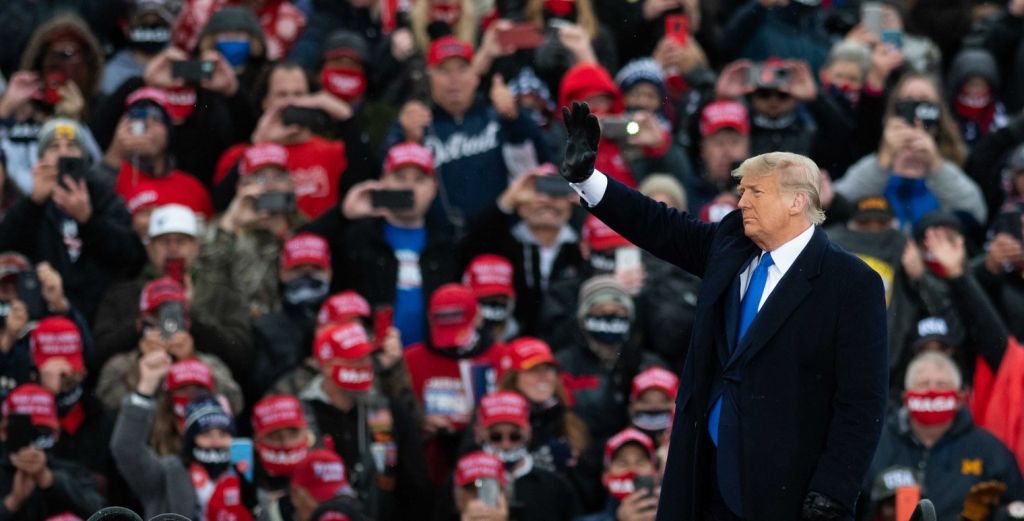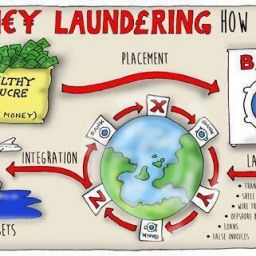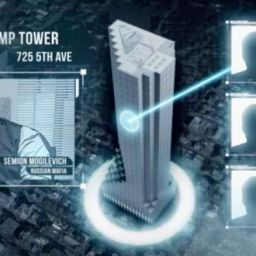For many years, the elite private members’ club has sustained the outgoing US president. But is it all about to fall apart?

As Donald Trump leaves office, the place that has come to symbolise Brand Trump is Mar-a-Lago – his 20-acre, 128-room private members’ club in Palm Beach, Florida. With much of the Trump business empire heavily indebted and losing money, Mar-a-Lago is one of its few genuine cash cows.
According to the Government Accountability Office, the US taxpayer has paid $1m a day for each of the days Trump has spent at Mar-a-Lago. “How much US taxpayers’ money was spent on ‘non-security improvements’ to Mar-a-Lago and Trump’s Bedminster [another private members’ club in New Jersey] residence?” the presidential historian Michael Beschloss recently asked, suggesting that the federal government could ask to be reimbursed, as it did with Richard Nixon’s California mansion after he left office.
Mar-a-Lago is what first made Trump ‘respectable’ in high society, and it has subsidised his lifestyle since well before he reached the presidency. All the while, as a private member’s club with hundreds of members and guests milling around during Trump’s visits, it has been cloaked in secrecy. Trump now plans to move back there – but is the dream about to fall apart?
Trump’s Golden Egg
It is often said that the Trump Organization isn’t really a coherent business, rather a hotch-potch of different boutique interests that have little in common. And as Trump’s leaked tax returns showed, most of those businesses are in the red. Even his luxury Washington DC hotel, used by Nigel Farage to launch his new UK political party, and favoured by diplomats seeking to lobby the president, has lost at least $32m in four years, according to a recent investigation by Forbes. The same report showed that Trump had lost a further $70m on his Doral Miami golf course.
Against this stands Mar-a-Lago. Since it opened as a private members’ club in 1994, the building has been a rare golden egg for Trump. While the Trump Organization’s accounting is shrouded in secrecy, recent revelations have started to shed light on how Mar-a-Lago underpins Brand Trump. The New York Times analysis of his leaked tax returns noted that joining fees for the club yielded $6m in 2016 – up from $664,000 two years earlier – and that between 2015 and 2018, the president took $26m in payments from Mar-a-Lago.
Mar-a-Lago’s dual status as a business and as Trump’s residence also allows him to subsidise his lifestyle. The New York Times elaborated on how this can be done with his taxes:
Mr. Trump may be reporting business losses to the government, but he can still live a life of wealth and write it off … As a business, [Mar-a-Lago] is also the source of millions of dollars in expenses deducted from taxable income, among them $109,433 for linens and silver and $197,829 for landscaping in 2017. Also deducted as a business expense was the $210,000 paid to a Florida photographer over the years for shooting numerous events at the club, including a 2016 New Year’s Eve party hosted by Mr. Trump.
The opulent mansion is not only invaluable for writing off tax obligations, it is also a reliable source of income – especially at a time when others are drying up. Trump’s presidency has been good for Mar-a-Lago’s business. Since 2015, according to the New York Times, Trump is understood to have taken an additional $5m a year from Mar-a-Lago.
This isn’t the first time a president’s private residence has benefited from taxpayers’ money
Trump has also refined the art of profiting from summit meetings held at his club. When leaders like Xi Jinping and Shinzo Abe have flown in, government records show that Trump has booked out all the guestrooms at Mar-a-Lago for the US secret service, billing the government. As the Pulitzer Prize-winning journalist David Fahrenthold comments, “they figured out what is the maximum you can charge the US government for a hotel room, and charged that.” At times, government websites have openly promoted the club.
This isn’t the first time a US president’s private residence has benefited from taxpayers’ money. Notoriously, Richard Nixon maintained both a “Winter White House” in Key Biscayne, Florida, and a “Western White House” at La Casa Pacifica, San Clemente, California. In addition to the usual enhancements around security and communications, Nixon made considerable additions to the property, including the addition of a helipad to his Florida house, the full cost of which was not disclosed until well after he had left office.
Previous coverage of Mar-a-Lago has focused on these financial benefits. Yet in operating his residence as a private member’s club, Trump enjoys other privileges, beyond monetary gain. He taps into a wider world based on secrecy and informal contacts.
The exclusive world of private members’ clubs
Trump bought Mar-a-Lago very cheaply in 1985. He originally wanted it to be a trophy home, not a club. The sprawling mansion, currently the 18th-largest house in the US, was built by the cereal heiress Marjorie Merriweather Post in the 1920s, but has always been unfeasibly expensive to maintain. She tried donating it to the US government in her will, for use as a ‘winter White House’, but the parsimonious Jimmy Carter administration gave it back to her foundation.
Enter Trump in the 1980s, at the time building unglamorous but profitable tower blocks in Brooklyn and Staten Island, and keen to escape his father’s shadow. Already stung by a 1973 federal prosecution for breaching discrimination laws against his tenants, Trump was eager to strut onto the national stage. The 1980s saw him make a series of flamboyant acquisitions – a string of casinos, a yacht, an airline, New York’s landmark Plaza Hotel – and the completion of the first of his increasingly outlandish Trump Towers.
Mar-a-Lago was the icing on the cake – for decades, New York’s ‘old money’ had been wintering in mansions on Palm Beach island, off the Florida coast. Trump’s neighbour Laurence Leamer shows in his book on Mar-a-Lago that after several years of haggling, the Mar-a-Lago estate, which had been advertised for $90 million, was sold to Trump for under $9m. Only $300,000 of that was his own money – the rest was from a secret $8.5m loan from the Chase Manhattan Bank, although in public, he invariably boasted he paid cash upfront.
Unfortunately for the hopelessly overleveraged Trump, his 1980s acquisitions were unsustainable, and as he sank deep into debt in the early 1990s, several of his companies went bankrupt. The casinos, the yacht, the airline, the Plaza Hotel – all were sold off. Mar-a-Lago, a cripplingly expensive vanity purchase, looked set to go the same way.

What saved Mar-a-Lago for Trump was the decision to turn it into a private members’ club. As Leamer revealed, this was not Trump’s own idea, although he often bragged that it was. It was that of his trusts and estates attorney, Paul Rampell.
Trump initially needed much persuading about the plan. He instinctively hated the world of Palm Beach’s snooty clubs – some of the most elitist clubs in the world, whose members had long looked down on him as an arriviste. Mar-a-Lago’s original founder had so loved this world that she had built her own next door to the mansion, the Bath and Tennis Club, even digging a private underground tunnel linking it to Mar-a-Lago. When Trump tried to join the Bath and Tennis Club as Mar-a-Lago’s new owner, he was blackballed by Palm Beach high society.
The idea of owning his own club grew on Trump, though – it would become his own world, where he could stride in as the centre of attention, and decide who to admit and who to keep out. In 1994, the Mar-a-Lago Club opened its doors for the first time.
The main advantage of a private members’ club is in the name: it’s private. It promotes connections in a private space, free from scrutiny. The money charged for American clubs, particularly those with country club facilities like Mar-a-Lago’s tennis courts and nearby golf course, can be eye-watering: $20,000 a year is quite normal, and a one-off joining fee of $50,000 or even $100,000 is not unheard of. Mar-a-Lago is therefore one of the most expensive clubs in the world – in the UK, for instance, membership of the most secretive and historic private clubs costs around £1,500 a year, still less than many gyms.
These sums don’t only exist to keep America’s clubs in strong financial health. They prevent the poor, or people demographically more likely to be poor, from ever joining. In past decades, it’s been quite candidly understood that high entrance fees helped to keep out non-white applicants – although that has somewhat been rolled back, with the growing diversification of the American workplace.
When Trump turned Mar-a-Lago into a club, he was in the right place at the right time. The major Palm Beach clubs of the 20th century were notorious for their exclusionary policies – ‘No Blacks and no Jews’, effectively – although they were careful to never invite a prosecution by enshrining these conventions into written rules. Instead, it just happened to be that amongst thousands of members, not a single Black or Jewish candidate had ever been elected. Apart from the Palm Beach Country Club, set up for Jewish members who had been excluded elsewhere, the ethnic and religious minority billionaires of Palm Beach had nowhere else to go – and in the 1990s, Palm Beach was becoming less Waspy, while Trump heralded a wave of new money, keen to flash their cash.
An unlikely rebel
In the 1990s, Trump was the somewhat improbable ‘inclusive’ face of Palm Beach. He made much of this when the Mar-a-Lago Club opened, boasting to the town council that if he “could leave one legacy to Palm Beach, it would be the creation of a non-sectarian club”. Of course, Trump is scarcely a paragon of inclusivity – there are reportedly tapes of his using the n-word in private – but it suited his purpose in getting planning permission to turn the mansion into a club. No one wanted to be publicly seen opposing Palm Beach’s first non-sectarian club, especially as the prices ensured that only the super-wealthy would join anyway.
Mar-a-Lago boasts the elite connections of private clubs, only with an even richer and more exclusive membership than most. While presidents have long appointed campaign donors as US ambassadors, the Trump presidency has seen a new twist on this, with at least five current or former members of his clubs having been given posts in countries including the Dominican Republic, Hungary, the Vatican, South Africa and Romania. Some of these have proved to be highly controversial appointments: David Cornstein, Trump’s ambassador to Hungary between 2018 and 2020, expressed strong support for the country’s far-right prime minister, Viktor Orban.
The club’s membership remains a closely-guarded secret
But influence can flow in more than one direction. Prospective members are not asked to produce any proof of the source of their $200,000 joining fee – a loophole, common to many clubs, that potentially allows agents of foreign governments to join with state-sponsored funds. Members can also book private functions at the club – like last month’s conference for the right-wing student organisation Turning Point USA, where the 2,000 guests were photographed at tables of ten without masks or social distancing.
The club’s membership list remains a closely guarded secret, although an aggregation of news reports from major media outlets lists 133 current or former members. All are millionaires, and many are billionaires. Wealth seems to be the primary requirement for membership: according to the Miami Herald, former members include the disgraced paedophile financier Jeffrey Epstein, although Epstein’s membership may have benefited from his friendship with Trump – as Trump told New York magazine in 2002, “I’ve known Jeff for 15 years, he’s a lot of fun to be with. It is even said that he likes beautiful women as much as I do, and many of them on the younger side. No doubt about it – Jeffrey enjoys his social life.” After Epstein’s conviction, a source close to Trump claimed the two had never been close.
Even with secret service protection, security at Mar-a-Lago has long been considered a joke, with gatecrashers common on the estate. Recent incursions included two Chinese citizens found carrying cell phones and USB sticks containing malware, various student pranksters, and an opera singer who bluffed her way in and pleaded insanity after a car chase.
There is a strict custom for approaching Trump at Mar-a-Lago – he enjoys impromptu walkabouts, meeting and greeting members informally. Buying membership will not buy a private meeting with Trump, but it will buy a ringside seat with his entourage, something that was dramatically highlighted in the first month of his presidency, when he dealt with a North Korean missile crisis while dining al fresco at his favourite table, within earshot of members milling around.
What happens now?
There are now clear signs that Trump intends to move full-time to the mansion. He changed his residency to Mar-a-Lago in 2019, his private apartment at the club was renovated last month, and Melania Trump is seeking out local schools for their youngest son Barron.
But the Trump family may have problems with their very rich and influential neighbours. Trump may have won Florida in 2016 and 2020, but Palm Beach is not Trump country. In last November’s election, Palm Beach County voted for Biden over Trump, by 56% to 43%. Four years earlier, Hillary Clinton won the county by 57% to 41%.
Trump was only allowed to turn Mar-a-Lago from his private home into a club after the town council granted permission for a change of use, in exchange for a series of legally binding promises set out in a Declaration of Use Agreement. In the document, drawn up in 1993, Trump agrees to turn over ownership of the building to a holding company, The Mar-a-Lago Club LLC (formerly the Mar-a-Lago Club Inc). The company, ownership of which Trump transferred to his son Donald Jr., is currently registered at the White House.
In September 2019, Trump officially designated Mar-a-Lago his primary residence for the first time. But this presents a possible legal minefield. In theory, Trump is still constrained by the original Declaration of Use Agreement, which sets out that no member, including Trump, shall reside at the Club for more than 21 days a year there – something which he is plainly already doing.
A Washington Post tally records Trump as having spent at least 130 days of his presidency there. Other outlets quote substantially higher figures. As early as December 2017, NBC News found that Trump had spent 133 days (over 4 months) of his first 10 months of his presidency at Mar-a-Lago.
Last month, lawyers for Trump’s next-door neighbours delivered a formal letter, stating that they would hold him to the 1993 agreement, and making it clear they did not wish him to reside there. Another stipulation of the agreement is that the club is only licensed to have a maximum of 500 members: according to Leamer’s book, Trump’s neighbours have argued that he’s long been well over that limit.
An openDemocracy analysis of the multi-million-dollar spike in joining fee income shown in Mar-a-Lago from Trump’s leaked tax returns suggests at least 100 new members signed up between 2014 and 2017, at a time when the joining fee was still only $100,000. (Trump doubled the fee on becoming president.) This in itself may be a serious under-estimate – not only because we have yet to see figures after 2017, but also because Trump has long been known to offer spur-of-the-moment discounts for friends, or for famous individuals he is keen to see become members. All this raises the question of just how many members Mar-a-Lago actually has.
Palm Beach is not Trump country
Trump’s departure from the White House may well prompt a new battle over his use of Mar-a-Lago. But there may also be more trivial irritations in store. He has long fought a rearguard action against flyovers from the private planes of Palm Beach’s billionaires, spending 30 years trying to reroute flights away from Mar-a-Lago. The land for the nearby Trump International Golf Course West Palm Beach is leased from Florida’s Department of Airports, in no small part to prevent its use for air traffic.
Upon becoming President, Trump had this long-festering grievance resolved in his favour: due to national security, all flights around Mar-a-Lago are grounded when the President is in residence. Now, he faces having to put up with one of his biggest bugbears once again.
This year’s annual black-tie gala New Year’s Eve party at Mar-a-Lago went ahead despite the pandemic, drawing complaints for the hundreds of maskless members and guests milling around. In its wake, Omari Hardy, a member of Florida’s House of Representatives and former Palm Beach Town Council member, has called for Mar-a-Lago to be shut down. Trump can expect this to be only the first of many attempts to remove his club licence.
The Trump Organization and representatives of Mr Trump did not respond to a request for comment.




